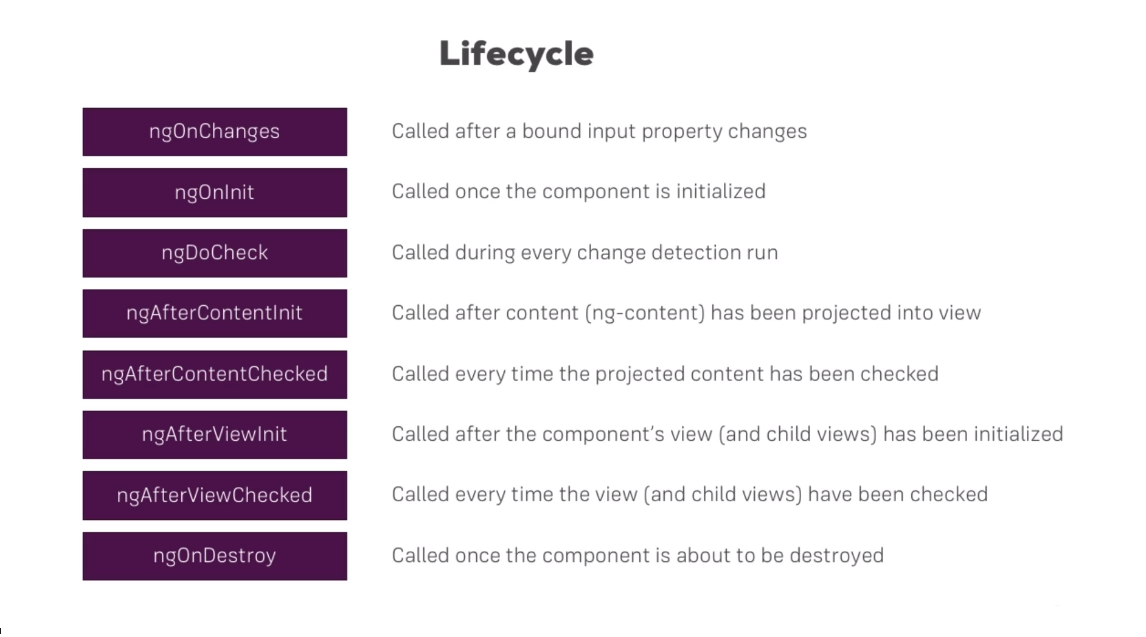An Angular project is made up of many components. When the application starts up, Angular runs the bootstrap sequence to build our application for display to the users. During the time when users are using the application, users click around to navigate between different pages. Components gets created, and components gets destroyed. But are those the only two stages of the lifecycle of a Angular component? The answer is no.
The lifecycle of an Angular component consists of 8 stages. (not counting constructor initialization)
The stages, in order are:
ngOnChangesngOnInitngDoCheckngAfterContentInitngAfterContentCheckedngAfterViewInitngAfterViewChecked- And lastly
ngOnDestroy
ngOnChanges - The first stage
This hook will run whenever one or more data-bound input properties change. This means if any bounded properties is changed, this hook will execute. For example, a property with the annotation @Input() changes, ngOnChanges will be executed. The ngOnChanges method receives a SimpleChanges object of current and previous property values.
Note that if your component has no inputs or you use it without providing any inputs, the framework will not call ngOnChanges().
Number of calls: many
When to use: hook on input() bounded changes
ngOnInit - The initialization
This hook is made for initialize of of class level properties in a component, or logic to be executed on start. ngOnInit initialize the directive or component after Angular first displays the data-bound properties and sets the directive or component’s Input() properties.
This hook is called once, after the first ngOnChanges(). ngOnInit() is still called even when ngOnChanges() is not.
Number of calls: once
When to use: start up logic, and initial values assignment
ngDoCheck - The change detection
This hook runs whenever Angular change detection runs.
Called immediately after ngOnChanges() on every change detection run, and immediately after ngOnInit() on the first run.
Number of calls: many
When to use: avoid using due to high amount of calls unless necessary
ngAfterContentInit - The external display
This hook runs when Angular is projecting the external content onto the view.
Called once after the first ngDoCheck().
Number of calls: once
When to use: hook after < ng-content > is projected
ngAfterContentChecked - The external display change detection
This hook runs after Angular checks the content projected into the directive or component.
Called after ngAfterContentInit() and every subsequent ngDoCheck().
Number of calls: many
When to use: avoid using due to amount of calls unless necessary
ngAfterviewInit - The template display
In addition to ngAfterContentInit(), this hook initializes the component’s views and child views.
Called once after the first ngAfterContentChecked().
Number of calls: once
When to use: logic that requires elements rendered already
ngAfterviewChecked - The external display change detection
This hook runs after Angular checks the component’s views and child views, or the view that contains the directive.
Called after the ngAfterViewInit() and every subsequent ngAfterContentChecked().
Number of calls: many
When to use: avoid using due to amount of calls unless necessary
ngOnDestroy - The external display change detection
This hook runs just before Angular destroys the directive or component.
Called immediately before Angular destroys the directive or component.
Number of calls: once
When to use: unsubscibe from Obseravble subscriptions, or other cleanup logic
Summary
This is a infographic of the Angular lifecycles that I found to be useful.

Each Angular lifecycle has its own purpose, but it does not mean you will be using all eight in every component. I have found the most useful hooks are ngOnInit, ngOnChanges, and ngOnDestroy. Let me know what you think the most useful hooks and why!